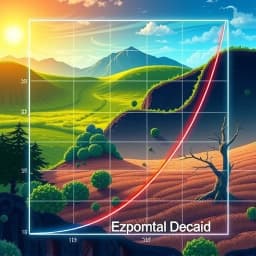
How to Write an Exponential Decay Function
Find this useful? Bookmark ( CTRL/CMD + D ) for quick access!
Try an example:
Radioactive Decay Modeling
Population Decline Analysis
Depreciation of Assets
Pharmaceutical Drug Efficacy
Cooling Process Simulation
Signal Attenuation Calculation
Explore Similar Tools
Recent Generations
the amount paid directly to you. Yes it is possible in future cases to request direct payment to the provider, Rephrase and give me polished email.
we have processed the claim as per the attachments in the claim submission we have processedthe invoice for Saul Holding. We dont have invoice for the Salofalk.
this additional information is very important. this adiitional information was requested by our clinical team. Without clinical review claim not be paid so please share the below additional information
How To Write An Exponential Decay Function
How To Write An Exponential Decay Function is a powerful AI-powered educational tool that helps users master the concept of exponential decay in mathematics. This innovative solution combines advanced algorithms with interactive learning features to deliver a comprehensive understanding of how to formulate and apply exponential decay functions effectively.
Key Capabilities
- Step-by-step guidance for writing exponential decay functions, ensuring users grasp the underlying principles and formulas.
- Interactive examples that illustrate real-world applications of exponential decay, enabling users to see the relevance of the concept in various fields.
- Customizable practice problems tailored to different skill levels, allowing users to reinforce their learning at their own pace.
- Instant feedback and explanations on user inputs, helping to clarify misconceptions and solidify understanding.
Who It's For
Designed for students, educators, and professionals, How To Write An Exponential Decay Function excels in academic settings and self-study environments. Whether you're a high school student preparing for exams or a college professor looking to enhance your curriculum, this tool streamlines your learning process and enhances comprehension.
Why Choose How To Write An Exponential Decay Function
What sets How To Write An Exponential Decay Function apart is its engaging, user-friendly interface and personalized learning experience, making it the ideal solution for anyone looking to master exponential decay functions.
Ready to transform your understanding of exponential decay? Start using How To Write An Exponential Decay Function today and experience the difference in your mathematical journey!
Enhance Your Work with How to Write an Exponential Decay Function
Leverage the power of AI to streamline your tasks with our How to Write an Exponential Decay Function tool.
Step-by-Step Guidance
Receive detailed instructions on how to formulate and write an exponential decay function, ensuring a clear understanding of each component.
Educational Resources
Access a variety of educational materials, including examples and explanations, to enhance your knowledge of exponential decay functions.
Code Snippets
Utilize pre-written code snippets for implementing exponential decay functions in various programming languages, streamlining your coding process.
How How to Write an Exponential Decay Function Works
Discover the simple process of using How to Write an Exponential Decay Function to improve your workflow:
Input Initial Values
Enter the initial value and decay constant for your exponential decay function.
Select Decay Type
Choose the type of exponential decay you want to model, such as radioactive decay or depreciation.
Generate Function
The tool calculates the exponential decay function based on your inputs and displays the equation.
Visualize Decay
View the graph of the exponential decay function to understand its behavior over time.
Use Cases of
How to Write an Exponential Decay Function
Explore the various applications of How to Write an Exponential Decay Function in different scenarios:
Environmental Science
Model the decay of pollutants in the environment over time to assess their long-term impact.
Pharmacokinetics
Calculate the rate at which drugs are eliminated from the body to optimize dosing schedules.
Population Dynamics
Study the decline of species populations due to factors like habitat loss or climate change.
Financial Forecasting
Analyze the depreciation of assets over time to inform investment and accounting decisions.
Who Benefits from How to Write an Exponential Decay Function?
AI-Powered Efficiency
From individuals to large organizations, see who can leverage How to Write an Exponential Decay Function for improved productivity:
Students
Learn how to model real-world phenomena using exponential decay functions in mathematics and science.
Researchers
Utilize exponential decay functions to analyze data trends and make predictions in various fields.
Data Scientists
Apply exponential decay models to enhance data analysis and improve machine learning algorithms.
Educators
Teach students the principles of exponential decay and its applications in real-life scenarios.
Frequently Asked Questions
What is an exponential decay function?
An exponential decay function is a mathematical function that describes the process of reducing an amount by a consistent percentage rate over a period of time. It is typically represented in the form y = a * e^(-bt), where 'a' is the initial amount, 'b' is the decay constant, and 't' is time.
How can I use this tool to write an exponential decay function?
To use the tool, simply input the initial value, decay constant, and the time period you are interested in. The tool will generate the corresponding exponential decay function for you.
What applications does an exponential decay function have?
Exponential decay functions are widely used in various fields such as physics, biology, finance, and environmental science. They can model processes like radioactive decay, population decline, and depreciation of assets.
Is there a limit to the values I can input into the tool?
While the tool can handle a wide range of values, it is recommended to use realistic and meaningful numbers for the initial value and decay constant to ensure the generated function is applicable to real-world scenarios.
Can I visualize the exponential decay function generated by the tool?
Yes, the tool includes a visualization feature that allows you to graph the exponential decay function, helping you to better understand how the function behaves over time.































